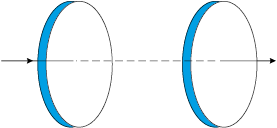8.1 Figure 8.6 shows a capacitor made of two circular plates each of radius 12 cm, and separated by 5.0 cm. The capacitor is being charged by an external source (not shown in the figure). The charging current is constant and equal to 0.15A.
(a) Calculate the capacitance and the rate of change of potential difference between the plates.
(b) Obtain the displacement current across the plates.
(c) Is Kirchhoff’s first rule (junction rule) valid at each plate of the capacitor? Explain.

Figure 8.6
(a)
Hint: \(Capacitance,~C=\frac{\epsilon _{0}A}{d}~and~q=CV\)
Step 1: Find capacitance.
The radius of each circular plate (r)
The distance between the plates (d)
Capacitance is given, where A =
Step 2: Find the rate of change of potential difference between the plates.
Charge on each plate, q = CV
Differentiating on both sides:
\(\frac{dq}{dt}=C\frac{dV}{dt}\)
(b)
Hint: The displacement current across the plates is equal to the conduction current.
Step: Find displacement current.
The displacement current is 0.15 A.
(c)
Hint: Recall Kirchhoff’s first law
Step: Take the sum of conduction and displacement current.
Yes, Kirchhoff’s first law (junction law) is valid at each plate of capacitor. We take into consideration both the conduction and displacement current.

© 2026 GoodEd Technologies Pvt. Ltd.